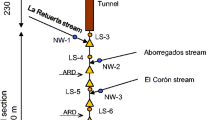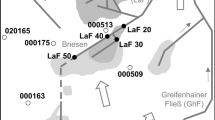Abstract
Acidic mine drainage (AMD) containing elevated concentrations of dissolved iron and other metals can be neutralized to varying degrees by reactions with limestone in passive treatment systems. We evaluated the chemical and mineralogical characteristics and the effectiveness of calcitic and dolomitic limestone for the neutralization of net-acidic, oxic, iron-laden AMD from a flooded anthracite mine. The calcitic limestone, with CaCO3 and MgCO3 contents of 99.8 and <0.1 wt%, respectively, and the dolomitic limestone, with CaCO3 and MgCO3 contents of 60.3 and 40.2 wt%, were used to construct a downflow treatment system in 2003 at the Bell Mine, a large source of AMD and baseflow to the Schuylkill River in the Southern Anthracite Coalfield, in east-central Pennsylvania. In the winter of 2002–2003, laboratory neutralization-rate experiments evaluated the evolution of effluent quality during 2 weeks of continuous contact between AMD from the Bell Mine and the crushed calcitic or dolomitic limestone in closed, collapsible containers (cubitainers). The cubitainer tests showed that: (1) net-alkaline effluent could be achieved with detention times greater than 3 h, (2) effluent alkalinities and associated dissolution rates were equivalent for uncoated and Fe(OH)3-coated calcitic limestone, and (3) effluent alkalinities and associated dissolution rates for dolomitic limestone were about half those for calcitic limestone. The dissolution rate data for the cubitainer tests were used with data on the volume of effuent and surface area of limestone in the treatment system at the Bell Mine to evaluate the water-quality data for the first 1.5 years of operation of the treatment system. These rate models supported the interpretation of field results and indicated that treatment benefits were derived mainly from the dissolution of calcitic limestone, despite a greater quantity of dolomitic limestone within the treatment system. The dissolution-rate models were extrapolated on a decadal scale to indicate the expected decreases in the mass of limestone and associated alkalinities resulting from the long-term reaction of AMD with the treatment substrate. The models indicated the calcitic limestone would need to be replenished approaching the 5-year anniversary of treatment operations to maintain net-alkaline effluent quality.



Similar content being viewed by others

References
American Public Health Association (1998a) Alkalinity (2320)/Titration method. In: Clesceri LS, Greenberg AE, Eaton AD (eds) Standard methods for the examination of water and Wastewater. 20th edn. American Public Health Assoc, Washington, DC, pp 2.26–2.30
American Public Health Association (1998b) Calcium (3500-Ca). In: Clesceri LS, Greenberg AE, Eaton AD (eds) Standard methods for the examination of water and wastewater, 20th edn, American Public Health Assoc, Washington, DC, pp 3.63–3.65
Ball JW, Nordstrom DK (1991) User’s manual for WATEQ4F with revised data base: USGS Open-File Report 91–183, www.brr.cr.usgs.gov/projects/GWC_chemtherm/pubs/wq4fdoc.pdf, 189 pp
Cravotta CA III (2003) Size and performance of anoxic limestone drains to neutralize acidic mine drainage. J Environ Qual 32:1277–1289
Cravotta CA III, Trahan MK (1999) Limestone drains to increase pH and remove dissolved metals from acidic mine drainage. Appl Geochem 14:581–606
Cravotta CA III, Ward SJ (2008) Downflow limestone beds for treatment of net-acidic, oxic, iron-laden drainage from a flooded anthracite mine, Pennsylvania, USA: 1. Field evaluation: Mine Water Environ (this issue)
Cravotta CA III, Ward SJ, Koury DJ, Koch RD (2004) Optimization of limestone drains for long-term treatment of acidic mine drainage, Swatara Creek Basin, Schuylkill County, PA. Proc, 2004 National Meeting of the American Soc of Mining and Reclamation and the 25th WV Surface Mine Drainage Task Force, pp 366–411
Cravotta CA III, Watzlaf GR (2002) Design and performance of limestone drains to increase pH and remove dissolved metals from acidic mine drainage. In: Naftz DL, Morrison SJ, Fuller CC, Davis JA (eds) Handbook of Groundwater remediation using permeable reactive barriers–applications to radionuclides, trace Metals, and nutrients. Academic Press, San Diego, pp 19–66
Hammarstrom JM, Sibrell PL, Belkin HE (2003) Characterization of limestone reacted with acid-mine drainage in a pulsed limestone bed treatment system at the Friendship Hill National Historic Site, Pennsylvania, USA. Appl Geochem 18:1705–1721
Hedin RS, Nairn RW, Kleinmann RLP (1994) Passive treatment of coal mine drainage. USBM IC 9389, 35 pp
Hedin RS, Watzlaf GR (1994) The effects of anoxic limestone drains on mine water chemistry. USBM SP 06A, pp 185–194
Hedwin Corporation (2007) Cubitainer® combination package: Baltimore, Md., Hedwin Corporation http://www.hedwin.com/library/pdfs/cubitainer_info.pdf, 3 pp
Herman JS, White WB (1985) Dissolution kinetics of dolomite–Effects of lithology and fluid flow velocity. Geochim Cosmochim Acta 49:2017–2026
Huminicki DMC, Rimstidt JD (2007) Neutralization of sulfuric acid solutions by calcite dissolution and the application to anoxic limestone drain design. Appl Geochem http://dx.doi.org/10.1016/j.apgeochem.2007.10.004
ICDD (2002) Powder Diffraction File release 2002, PDF-2. International Centre for Diffraction Data, Newton Square
Kirby CS, Cravotta CA III (2005a) Net alkalinity and net acidity 1: Theoretical considerations. Appl Geochem 20:1920–1940
Kirby CS, Cravotta CA III (2005b) Net alkalinity and net acidity 2: Practical considerations. Appl Geochem 20:1941–1964
Kirby CS, Thomas HM, Southam G, Donald R (1999) Relative contributions of abiotic and biological factors in Fe(II) oxidation in mine drainage. Appl Geochem 14:511–530
Langmuir D (1997) Aqueous Environmental Geochemistry. Prentice-Hall, NJ, USA, 600 pp
Morse JW (1983) The kinetics of calcium carbonate dissolution and precipitation. In: Reeder RJ (ed) Carbonates–mineralogy and chemistry. Mineral Soc America Rev Mineral 11:227–264
O’Neill BJ Jr (1964) Limestones and dolomites of Pennsylvania. Atlas of Pennsylvania’s mineral resources, PA Geol Survey Mineral Resource Report 50, pp 1–40, map 9
Pennsylvania Dept of Environmental Protection (2000) Erosion and sediment pollution control program manual. PA DEP, Bureau of Watershed Mgmt, Doc # 363–2134–008, tables 9 and 10A, Harrisburg, PA, USA, 180 pp
Plummer LN, Parkhurst DL, Wigley ML (1979) Critical review of the kinetics of calcite dissolution and precipitation. In: Jenne EA (ed) Chemical modeling in aqueous systems–speciation, sorption, solubility, and kinetics: American Chemical Society Symp Series 93, pp 537–573
PIRAMID Consortium (2003) Engineering guidelines for the passive remediation of acidic and/or metalliferous mine drainage and similar wastewaters. European Commission 5th Framework RTD Project # EVK1-CT- 1999–000021, “Passive in-situ remediation of acidic mine/industrial drainage” (PIRAMID), Univ of Newcastle Upon Tyne, Newcastle Upon Tyne, UK, 166 pphttp://www.ncl.ac.uk/environment/research/documents/PIRAMIDGuidelinesv1.0.pdf
Robbins EI, Nord GL, Savela CE, Eddy J, Livi KJT, Gullett CD, Nordstrom DK, Chou I-M, Briggs KM (1996) Microbial and mineralogical analysis of aluminum-rich precipitates that occlude porosity in a failed anoxic limestone drain, Monongalia County, West Virginia. In: Chiang S-H (ed) Proc 13th Annual International Pittsburgh Coal Conf, v 2. Reed & Witting Co, Pittsburgh, pp 761–767
Robbins EI, Cravotta CA III, Savela CE, Nord GL Jr (1999) Hydrobiogeochemical interactions in “anoxic” limestone drains for neutralization of acidic mine drainage. Fuel 78:259–270
Santomartino S (2004) A laboratory study of limestone dissolution within passive limestone systems for treatment of acidic mine drainage and the implications of Fe precipitation on their longevity. LaTrobe Univ, Unpubl PhD thesis, 200 pp
Santomartino S, Webb JA (2007) Estimating the longevity of limestone drains in treating acid mine drainage containing high concentrations of iron. Appl Geochem 22:2344–2361
Schueck JH, Helfrich DR, Fromell DJ (2004) Limestone upflow pond with siphon discharge design considerations–a simple solution to high volume, high metals AMD discharges. Proc, 6th Annual statewide conf on abandoned mine reclamation, Indiana , Western PA Coalition for Abandoned Mine Reclamation, Bedford, 23 pp
Skousen JG, Rose AW, Geidel G, Foreman J, Evans R, Hellier W (1998) Handbook of technologies for avoidance and remediation of acid mine drainage. National Mine Land Reclamation Center, Morgantown, 131 pp
Sterner PL, Skousen JJ, Donovan JJ (1998) Geochemistry of laboratory anoxic limestone drains. Proc, 1998 national meeting of the American Soc for Surface Mining and Reclamation, pp 214–234
Stumm W, Morgan JJ (1996) Aquatic chemistry–chemical equilibria and rates in natural waters. 3rd edn, Wiley Interscience, NY 1022 pp
Taggart JE Jr (2002) Analytical methods for chemical analysis of geologic and other materials, USGS Open-File Report 02–0223, http://pubs.usgs.gov/of/2002/ofr-02-0223/
Taylor JC, Clapp RA (1992) New features and advanced applications of Siroquant: A personal computer XRD full profile quantitative analysis software package. Adv X-ray Anal 35:49–55
Watzlaf GR (1997) Passive treatment of acid mine drainage in down-flow limestone systems. Proc, 1997 national meeting of the American soc for surface mining and reclamation, May 10–15, 1997, Austin, American Soc for Surface Mining and Reclamation, pp 611–622
Watzlaf GR, Hedin RS (1993) A method for predicting the alkalinity generated by anoxic limestone drains. Proc, 14th annual meeting WV Surface Mine Drainage Task Force, WV Univ, Morgantown, WV, USA, 12 pp
Watzlaf GR, Schroeder KT, Kairies C (2000) Long-term performance of alkalinity-producing passive systems for the treatment of mine drainage. Proc, 2000 national meeting of the American Soc for Surface Mining and Reclamation, pp 262–274
Watzlaf GR, Schroeder KT, Kleinmann RLP, Kairies CL, Nairn RW (2004) The passive treatment of coal mine drainage. US DOE/NETL-2004/1202http://www.netl.doe.gov/technologies/coalpower/ewr/water/pdfs/Passive%20Treatment.pdf
Weaver KR, Lagnese KM, Hedin RS (2004) Technology and design advances in passive treatment system flushing. Proc, 2004 national meeting of the American Soc for Surface Mining and Reclamation and the 25th west Virginia S, April 18–24, 2004, pp 1974–1989
Acknowledgments
This project was conducted by the US Geological Survey (USGS) in cooperation with the Schuylkill Conservation District (SCD) and the Pennsylvania Department of Environmental Protection (PaDEP). Michael Asmussen, student volunteer formerly of Dickinson College, conducted measurements and computations of physical properties of limestone. The manuscript benefited from reviews by Kevin Breen, Daniel Hippe, Robert Runkel, and Dorothy Tepper of USGS and two anonymous reviewers. Use of trade, firm, or product names is for descriptive purposes only and does not imply endorsement by the U.S. Government.
Author information
Authors and Affiliations
Corresponding author
Rights and permissions
About this article
Cite this article
Cravotta, C.A., Ward, S.J. & Hammarstrom, J.M. Downflow Limestone Beds for Treatment of Net-Acidic, Oxic, Iron-Laden Drainage from a Flooded Anthracite Mine, Pennsylvania, USA: 2. Laboratory Evaluation. Mine Water Environ 27, 86–99 (2008). https://doi.org/10.1007/s10230-008-0031-y
Received:
Accepted:
Published:
Issue Date:
DOI: https://doi.org/10.1007/s10230-008-0031-y



